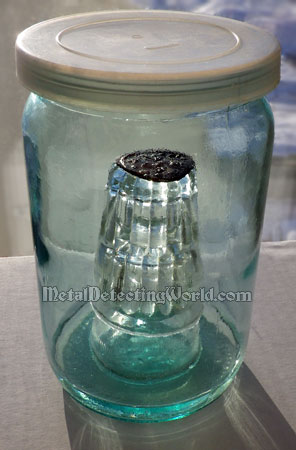A Complete Guide To Cleaning and Preservation of Coins, page 22
HOW TO TARNISH SILVER and COPPER COINS: Effective Methods and Applications
HOW TO TARNISH SILVER COINS
Silver coins tarnish naturally under the influence of sulfur. If coins are cleaned and have lost their tarnish, it may be desirable for aesthetic reasons (Standards for Aesthetic Appearance described on page 5) to restore the original tarnish. This is done with sulfur too; what nature does over long periods of time thus is restored quickly.
The following methods are used for silver coin tarnishing:
1) Potassium Sulfide Method: Potassium sulfide (K2S, potassium sulfuratum) is mixed in a 1:5 ratio with water in a small saucer. It dissolves in a few minutes, forming hydrogen sulfide. Each coin is dipped briefly, for a few minutes, into the liquid. The coins are moved around and turned over. When the desired tarnish is achieved, the process is ended by brief soaking.
There are coins that are tarnished in spots if the removal of dirt has left bright areas. In this case potassium sulfide solution is applied to a stick of cotton wool, or a Q-Tip, and the coin is dabbed for a few minutes or until the area in question shows the desired tarnish.
2) Sulfur method: This is a better method for tarnishing silver coins because the method described above causes undesirable discoloration, bluish, greenish or reddish - a Rainbow Effect caused by the film of potassium sulfide. If such discoloration occurs, Sulfur (S, sulfur depurativum) may be used instead. Sulfur can be obtained in yellow powder.
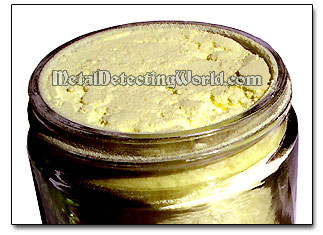
The sulfur method can be done in two ways:
A. Yellow sulfur powder is dispersed in water (with a 1:5 or thinner solution ratio) in a closed glass container. Some Joy dish detergent may be added to improve emulsification in water. A solution in water does not occur. The mixture can be kept in the glass container.
The coins are introduced and are turned and moved frequently. With a 1:5 or thinner solution ratio, the coins become tarnished in a period of 30 minutes to 12 hours. The coins can first be brightened before this treatment.
B. Yellow sulfur powder is mixed with Vaseline, with a 1:5 or thinner mixture ratio. The mixture can be kept in the glass container. The sulfur/Vaseline paste is spread on the coin's surface and kept on it until the coin shows the desired tarnish. The paste can be washed off the coin by gasoline.
I find the latter method more effective and less messy. The sulfur/Vaseline ratio of the paste can be changed as desired, thus allowing to regulate the timing and effect of tarnishing. The paste is harmless and can be kept and used for fairly long periods.
HOW TO TARNISH COPPER COINS
Tarnishing of copper coins can be achieved by the following methods:
1) Acetic Acid or Vinegar Method: the coins are spotted with acetic acid or vinegar, producing verdigris.
2) Sulfur Method:
• Sulfur/Vaseline Paste Treatment: Yellow sulfur powder is mixed with Vaseline, with a 1:5 or thinner mixture ratio. Just make sure you mix sulphur with vaseline evenly. The mixture can be kept in the glass container. The coin is simply covered with a thin layer of the sulfur/Vaseline paste and kept in it until the coin shows the desired tarnish. The paste can be washed off the coin by gasoline.
Below are the pictures of an 18th century jetton which was cleaned by Ammonia bath first and then tarnished with Sulfur method.
A Jetton Before Being Treated
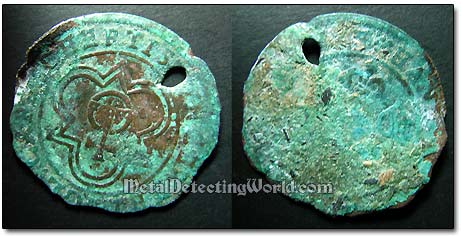
The Same Jetton After Being Cleaned and Tarnished by Sulfur/Vaseline Paste
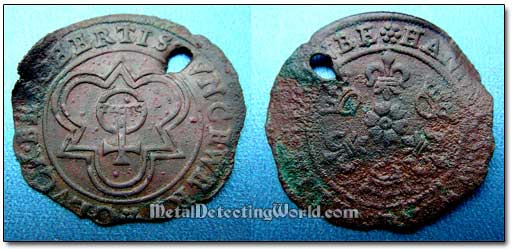
The sulfur/Vaseline ratio of the paste can be changed as desired, thus allowing to regulate the timing and effect of tarnishing. I usually make a low ratio, though 1:5 is fine, and achieve a desirable tarnish tone by timing - it is better to wait longer than to tarnish a coin too dark. The paste is harmless and can be kept and used for fairly long periods.
• Aqueous Sulfur Bath: An aqueous solution of Sulfur (S, sulfur depurativum) with a concentration of 1:5 is prepared. The dissolving takes several minutes. The copper coins are immersed into this solution for a short time, either for a fraction of a second by which they darken immediately, or for several minutes which turns them black.
3) Potassium Sulfide Method: the potassium sulfide (K2S, potassium sulfuratum) method can be used on copper coins that have become too bright by necessary cleaning. An aqueous solution of potassium sulfide with a concentration of 1:5 is prepared. The dissolving takes several minutes. The copper coins are immersed into this solution for a short time, for a fraction of a second.
If this makes the coins too red, then the process is continued for a few seconds until they become almost black.
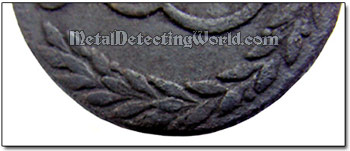
They are then immersed into water and the sulfur sludge is rubbed away with the fingers (harmless). Alternately they are again cleaned and the immersion is repeated more briefly. In this manner the copper coins obtain an absolutely natural appearance of tarnishing through age.
4) Ammonium Sulfate Method: The coins are immersed for 12 hours in 10% Ammonium Sulfate (NH4)2SO4 solution, and then air dried. This treatment is to be repeated several times.
5) Carbon Dioxide Method: The coins, together with a saucer of Hydrochloric acid (HCl) and marble pieces, are placed under a bell jar for some time so that the copper is attacked by the carbon dioxide which is produced.
6) Herring Pickle Method: the coins are placed in pickled herring solution for three months.
7) Ammonia Dabbing Method: the copper coins are dabbed repeatedly with an ammonia solution (aqueous ammonia).
8) Ammonia Vapor Method: This is an old method of tarnishing copper or bronze coins. After you remove encrustation from a copper coin, down to bare metal, you can artificially tarnish or patinate the coin by doing the following:
1) Place the coin on an elevated glass stand (I use two shot glasses inserted into one another as shown on a picture below) in a glass jar with an airtight plastic lid.
2) Carefully pour 1/4 cup of regular household Ammonia into the jar and below the level of the glass stand, and close the lid tight.
3) Place the jar (move it carefully not to let the coin slide off the stand and down into the Ammonia!) on a sunny windowsill for a couple of days.
Heated by the sun rays, the Ammonia vapor will fill the space around the coin inside the jar and, in conjunction with oxygen, darken the coin's surface. Do not leave the coin unchecked for long, or it will turn black! After you get satisfactory results, rinse and soak the coin in distilled water, dehydrate the coin in acetone, and coat the coin with microcrystalline wax to protect it from environmental effects.
Simple Setup for Tarnishing a Copper Coin in Ammonia Vapor
